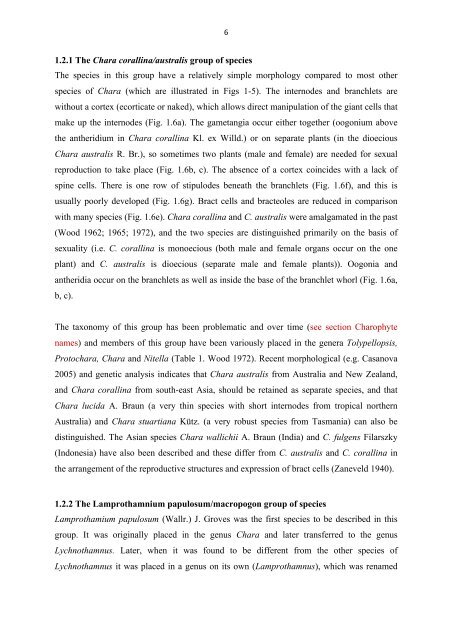Chapter 1: The Characeae Plant
Chapter 1: The Characeae Plant
Chapter 1: The Characeae Plant
You also want an ePaper? Increase the reach of your titles
YUMPU automatically turns print PDFs into web optimized ePapers that Google loves.
6 <br />
1.2.1 <strong>The</strong> Chara corallina/australis group of species<br />
<strong>The</strong> species in this group have a relatively simple morphology compared to most other<br />
species of Chara (which are illustrated in Figs 1-5). <strong>The</strong> internodes and branchlets are<br />
without a cortex (ecorticate or naked), which allows direct manipulation of the giant cells that<br />
make up the internodes (Fig. 1.6a). <strong>The</strong> gametangia occur either together (oogonium above<br />
the antheridium in Chara corallina Kl. ex Willd.) or on separate plants (in the dioecious<br />
Chara australis R. Br.), so sometimes two plants (male and female) are needed for sexual<br />
reproduction to take place (Fig. 1.6b, c). <strong>The</strong> absence of a cortex coincides with a lack of<br />
spine cells. <strong>The</strong>re is one row of stipulodes beneath the branchlets (Fig. 1.6f), and this is<br />
usually poorly developed (Fig. 1.6g). Bract cells and bracteoles are reduced in comparison<br />
with many species (Fig. 1.6e). Chara corallina and C. australis were amalgamated in the past<br />
(Wood 1962; 1965; 1972), and the two species are distinguished primarily on the basis of<br />
sexuality (i.e. C. corallina is monoecious (both male and female organs occur on the one<br />
plant) and C. australis is dioecious (separate male and female plants)). Oogonia and<br />
antheridia occur on the branchlets as well as inside the base of the branchlet whorl (Fig. 1.6a,<br />
b, c).<br />
<strong>The</strong> taxonomy of this group has been problematic and over time (see section Charophyte<br />
names) and members of this group have been variously placed in the genera Tolypellopsis,<br />
Protochara, Chara and Nitella (Table 1. Wood 1972). Recent morphological (e.g. Casanova<br />
2005) and genetic analysis indicates that Chara australis from Australia and New Zealand,<br />
and Chara corallina from south-east Asia, should be retained as separate species, and that<br />
Chara lucida A. Braun (a very thin species with short internodes from tropical northern<br />
Australia) and Chara stuartiana Kütz. (a very robust species from Tasmania) can also be<br />
distinguished. <strong>The</strong> Asian species Chara wallichii A. Braun (India) and C. fulgens Filarszky<br />
(Indonesia) have also been described and these differ from C. australis and C. corallina in<br />
the arrangement of the reproductive structures and expression of bract cells (Zaneveld 1940).<br />
1.2.2 <strong>The</strong> Lamprothamnium papulosum/macropogon group of species<br />
Lamprothamium papulosum (Wallr.) J. Groves was the first species to be described in this<br />
group. It was originally placed in the genus Chara and later transferred to the genus<br />
Lychnothamnus. Later, when it was found to be different from the other species of<br />
Lychnothamnus it was placed in a genus on its own (Lamprothamnus), which was renamed
















